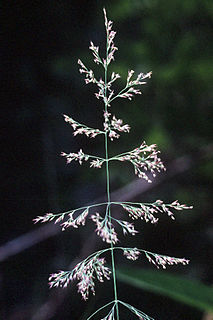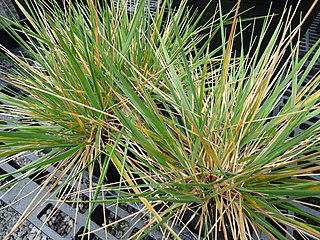
Calamagrostis is a genus of flowering plants in the grass family Poaceae, with about 260 species that occur mainly in temperate regions of the globe. Towards equatorial latitudes, species of Calamagrostis generally occur at higher elevations. These tufted perennials usually have hairless narrow leaves. The ligules are usually blunt. The inflorescence forms a panicle. Some may be reed-like.

Note that information on this species applies to Western Europe and some details may not be consistent with the species in other parts of its range.

Archon apollinus, the false Apollo, is a species of butterfly belonging to the Parnassinae subfamily.
Calamagrostis aurea is a species of grass in the family Poaceae. It is found only in Ecuador.
Calamagrostis carchiensis is a species of grass in the family Poaceae. It is found only in Ecuador.
Calamagrostis ecuadoriensis is a species of grass in the family Poaceae. It is found only in Ecuador.

Calamagrostis expansa is a species of grass in the family Poaceae known by the common name Maui reedgrass. It is native to Hawaii, where it is known only from Maui and the island of Hawaiʻi. Its natural habitats are lowland moist forests and swamps. It is threatened by habitat loss.
Calamagrostis fulgida is a species of grass in the family Poaceae. It is found only in Ecuador and parts of Chile.

Calamagrostis hillebrandii is a species of grass in the family Poaceae known commonly as Hillebrand's reedgrass. It is endemic to Maui in Hawaii, where there are only two known subpopulations with a total of perhaps 500 individuals. This is a federally listed endangered species of the United States.
Calamagrostis llanganatensis is a species of grass in the family Poaceae. It is found only in Ecuador.
Calamagrostis steyermarkii is a species of grass in the family Poaceae. It is found only in Ecuador.
Calamagrostis teretifolia is a species of grass in the family Poaceae. It is found only in Ecuador.

The lesser red musk shrew is a species of mammal in the family Soricidae. It is found in Angola, Botswana, Democratic Republic of the Congo, Malawi, Mozambique, Namibia, South Africa, Eswatini, Tanzania, Zambia, and Zimbabwe. Its natural habitats are dry savanna, moist savanna, subtropical or tropical dry lowland grassland, and hot deserts.
Genophantis leahi was a species of moth in the family Pyralidae described by Otto Herman Swezey in 1910. It was endemic to the Hawaiian islands of Maui, Oahu, Molokai and Hawaii.
Aquilaria hirta is a species of plant in the Thymelaeaceae family. It is found in Malaysia and Indonesia. Aquilaria hirta are suited for carving and hard like stone, but the species of Aquilaria hirta are seldom used in perfume and incense due to rarity.
Rondeletia hirta is a species of plant in the family Rubiaceae. It is endemic to Jamaica. It is threatened by habitat loss.

Amphinotus nymphula is an insect species endemic to the Seychelles group of islands. It is a restricted range species with an area of occupancy ranging 10 square kilometres (3.9 sq mi), bounded by a protected area. The primary habitat of this species is leaf litter and moss on trees in cloud forests. The species is threatened by habitat deterioration and its sensitivity to climate change. Females of the species are more often found close to the invasive plant Clidemia hirta compared to males. It is hypothesized that the invasive plant species has a negative effect on Tetrigidae as it changes the microclimate in the habitat by changing the habitat's structure and providing more shade. Possibly, the males of the species are more sensitive to any changes, as they are relatively more active than the females and may require more sunlight.
Diplotaxis hirta is a species of flowering plants of the family Brassicaceae. The species is endemic to Cape Verde. It is listed as an endangered plant by the IUCN.







